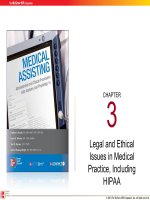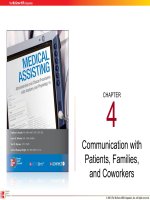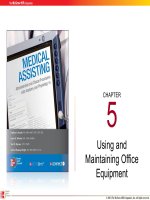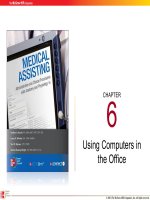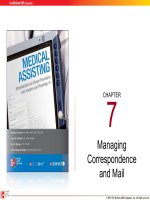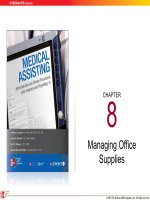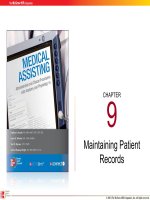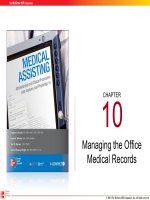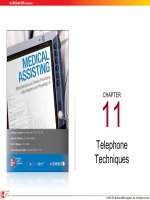Lecture Medical assisting: Administrative and clinical procedures with anatomy and physiology (4/e) – Chapter 23
Bạn đang xem bản rút gọn của tài liệu. Xem và tải ngay bản đầy đủ của tài liệu tại đây (1.81 MB, 68 trang )
CHAPTER
23
The Cardiovascular
System
© 2011 The McGraw-Hill Companies, Inc. All rights reserved.
232
Learning Outcomes
23.1 Describe the structure of the heart and the
function of each part.
23.2 Trace the flow of blood through the heart.
23.3 List the most common heart sounds and
what events produce them.
23.4 Explain how heart rate is controlled by the
electrical conduction system of the heart.
© 2011 The McGraw-Hill Companies, Inc. All rights reserved.
233
Learning Outcomes (cont.)
23.5 List the different types of blood vessels and
describe the functions of each.
23.6 Define blood pressure and tell how it is
controlled.
23.7 Trace the flow of blood through the
pulmonary and systemic circulation.
23.8 List the major arteries and veins of the body
and describe their locations.
© 2011 The McGraw-Hill Companies, Inc. All rights reserved.
234
Learning Outcomes (cont.)
23.9 List and describe the components of blood.
23.10 Give the functions of red blood cells, the
different types of white blood cells, and
platelets.
23.11 List the substances normally found in
plasma.
23.12 Explain how bleeding is controlled.
23.13 Explain the differences among blood types
A, B, AB, and O.
© 2011 The McGraw-Hill Companies, Inc. All rights reserved.
235
Learning Outcomes (cont.)
23.14 Explain the difference between Rh-positive
blood and Rh-negative blood.
23.15 Explain the importance of blood typing and
tell which blood types are compatible.
23.16 Describe the causes, signs and symptoms,
and treatments of various diseases and
disorders of the cardiovascular system.
© 2011 The McGraw-Hill Companies, Inc. All rights reserved.
236
Introduction
•
The cardiovascular system consists of heart
and blood vessels
•
Sends blood to
– Lungs for oxygen
– Digestive system for nutrients
•
Also circulates waste products to certain
organ systems for removal from the blood
© 2011 The McGraw-Hill Companies, Inc. All rights reserved.
237
Structures of the Heart
•
•
•
•
Cone-shaped organ
about the size of a
loose fist
In the mediastinum
Extends from the
level of the second rib
to about the level of
the sixth rib
Slightly left of the
midline
© 2011 The McGraw-Hill Companies, Inc. All rights reserved.
238
Structures of the Heart (cont.)
Heart is bordered:
Laterally by the lungs
Posteriorly by the vertebral
column
Anteriorly by the sternum
Rests on the diaphragm
inferiorly
© 2011 The McGraw-Hill Companies, Inc. All rights reserved.
239
Structures of the Heart (cont.)
•
Heart coverings
– Pericardium
•
•
Covers the heart and
large blood vessels
attached to the heart
Visceral pericardium
– Innermost layer
– Directly on the heart
•
Parietal pericardium
– Layer on top of the
visceral pericardium
Click for Larger View
• Heart walls:
– Epicardium
• Outermost layer
• Fat to cushion heart
– Myocardium
• Middle layer
• Primarily cardiac muscle
– Endocardium
• Innermost layer
• Thin and smooth
• Stretches as the heart
pumps
© 2011 The McGraw-Hill Companies, Inc. All rights reserved.
2310
Back
© 2011 The McGraw-Hill Companies, Inc. All rights reserved.
2311
Structures of the Heart (cont.)
•
Four chambers
– Two atria
•
•
•
Upper chambers
Left and right
Separated by
interatrial septum
– Two ventricles
•
•
•
Lower chambers
Left and right
Separated by
interventricular
septum
Atrioventricular septum separates the atria
from the ventricles
Click for
View of
Heart
© 2011 The McGraw-Hill Companies, Inc. All rights reserved.
2312
Structures of the Heart (cont.)
•
•
•
•
Tricuspid valve – prevents blood from flowing
back into the right atrium when the right ventricle
contracts
Bicuspid (mitral) valve – prevents blood from
flowing back into the left atrium when the left
ventricle contracts
Pulmonary semilunar valve – prevents blood
from flowing back into the right ventricle
Aortic semilunar valve – prevents blood from
flowing back into the left ventricle
Click for
View of
Heart
© 2011 The McGraw-Hill Companies, Inc. All rights reserved.
2313
The Heart Labeled
Back
© 2011 The McGraw-Hill Companies, Inc. All rights reserved.
2314
Blood Flow Through the Heart
Deoxygenated
blood in from
body
Oxygenated
blood out to
body
Oxygenated blood
in lungs
Deoxygenated
blood out
to lungs
Atria Contract
Ventricles Contract
© 2011 The McGraw-Hill Companies, Inc. All rights reserved.
2315
Blood Flow Through the Heart (cont.)
Right
Atrium
Tricuspid
Valve
Right
Ventricle
Pulmonary
Valve
Body
Lungs
Aortic
Semilunar
Valve
Left
Ventricle
Bicuspid
Valve
Left
Atrium
Pulmonary
Semilunar
Valve
© 2011 The McGraw-Hill Companies, Inc. All rights reserved.
2316
Cardiac Cycle
One heartbeat = one cardiac cycle
Atria contract and relax
Ventricles contract and relax
• Right atrium contracts
– Tricuspid valve opens
– Blood fills right ventricle
• Right ventricle contracts
– Tricuspid valve closes
– Pulmonary semilunar valve
opens
– Blood flows into pulmonary
artery
• Left atrium contracts
– Bicuspid valve opens
– Blood fills left ventricle
• Left ventricle contracts
– Bicuspid valve closes
– Aortic semilunar valve
opens
– Blood pushed into aorta
© 2011 The McGraw-Hill Companies, Inc. All rights reserved.
2317
Cardiac Cycle (cont.)
• Influenced by
– Exercise
– Parasympathetic nerves
– Sympathetic nerves
– Cardiac control center
– Body temperature
– Potassium ions
– Calcium ions
© 2011 The McGraw-Hill Companies, Inc. All rights reserved.
2318
Heart Sounds
•
One cardiac cycle – two heart sounds
(lubb and dubb) when valves in the heart
snap shut
– Lubb – first sound
•
When the ventricles contract, the tricuspid and
bicuspid valves snap shut
– Dubb – second sound
•
When the atria contract and the pulmonary and
aortic valves snap shut
© 2011 The McGraw-Hill Companies, Inc. All rights reserved.
2319
Cardiac Conduction System
• Group of structures that send electrical impulses through
the heart
• Sinoatrial node (SA node)
–
–
–
–
Wall of right atrium
Generates impulse
Natural pacemaker
Sends impulse to AV node
• Atrioventricular node (AV
node)
•
Bundle of His
– Between ventricles
– Two branches
– Sends impulse to Purkinje
fibers
•
– Between atria just above ventricles
– Atria contract
– Sends impulse to the bundle of His
Purkinje fibers
– Lateral walls of ventricles
– Ventricles contract
Click the i below for a
Diagram
© 2011 The McGraw-Hill Companies, Inc. All rights reserved.
2320
Cardiac
Conduction
System
Back
© 2011 The McGraw-Hill Companies, Inc. All rights reserved.
2321
Apply Your Knowledge
Match the following:
ANSWER:
C Tricuspid valve
__
A. Two branches; sends impulse to Purkinje
fibers
F Bicuspid valve
__
B. Covering of the heart and aorta
B Pericardium
__
C. Between the right atrium and the right
ventricle
E SA node
__
D. In the lateral walls of ventricles
A Bundle of His
__
E. Natural pacemaker
D Purkinje fibers
__
F. Between the left atrium and the left ventricle
© 2011 The McGraw-Hill Companies, Inc. All rights reserved.
2322
Blood Vessels
• Closed pathway that
carries blood from the
heart to cells and
back to the heart
• Types
– Arteries
– Arterioles
– Veins
– Venules
– Capillaries
© 2011 The McGraw-Hill Companies, Inc. All rights reserved.
2323
Arteries and Arterioles
•
•
•
Strongest of the
blood vessels
Carry blood away
from the heart
Under high pressure
– Vasoconstriction
– Vasodilation
•
Arterioles
– Small branches of
arteries
• Aorta
– Takes blood from the
heart to the body
• Coronary arteries
– Supply blood to heart
muscle
© 2011 The McGraw-Hill Companies, Inc. All rights reserved.
2324
Veins and Venules
•
Blood under no pressure
in veins
– Does not move very easily
– Skeletal muscle
contractions help move
blood
– Sympathetic nervous
system also influences
pressure
•
Valves prevent backflow
• Venules
– Small vessels formed when
capillaries merge
• Superior and inferior vena
cava
– Largest veins
– Carry blood into right
atrium
© 2011 The McGraw-Hill Companies, Inc. All rights reserved.
2325
Capillaries
•
Branches of arterioles
•
Smallest type of blood vessel
•
Connect arterioles to venules
•
Only about one cell layer thick
•
Oxygen and nutrients can pass out of a capillary into
a body cell
•
Carbon dioxide and other waste products pass out of
a body cell into a capillary
© 2011 The McGraw-Hill Companies, Inc. All rights reserved.

